ARE THESE KUNGFU PATTERNS REALISTIC AND PRACTICAL IN COMBAT?
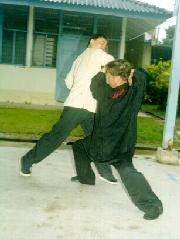 The webpage on the Application of Hoong Ka Kungfu has been well received. Many people have expressed their appreciation that finer points of kungfu application, which are not commonly mentioned in modern day kungfu writing, are explained. Some, understandably, are amazed that seemingly flowery patterns can be so useful in combat.
The webpage on the Application of Hoong Ka Kungfu has been well received. Many people have expressed their appreciation that finer points of kungfu application, which are not commonly mentioned in modern day kungfu writing, are explained. Some, understandably, are amazed that seemingly flowery patterns can be so useful in combat.
One reader, however, questioned whether the patterns were realistic and usable. If you take in isolation the combat situation shown in the picture above, then it is "unrealistic", as no one would leave his arm for you to break as in this pattern. In the same vein all kungfu patterns, including very simple ones like thrust punches and side kicks, are "unrealistic" in the sense that opponents would not freeze in their positions for you to apply your attacks.
The kungfu patterns are also "unnatural" in the sense that they do not come to fighters naturally; they have to train themselves for some time to be able to use the patterns. Mainly for this reason, many people resort to natural fighting, which is not much different from children's fighting. A kungfu fighter is a trained fighter, but he is so well trained that he can use his kungfu patterns, which may be unnatural to other people, naturally.
All kungfu patterns, including those from Taijiquan, that we have inherited from past masters are the crystalized forms of their centuries of actual fighting experiences. In other words from countless techniques that people had used in the past, these masters stylized them into kungfu patterns and continued to improve upon them over the centuries.
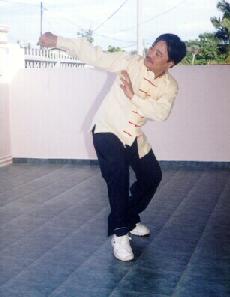
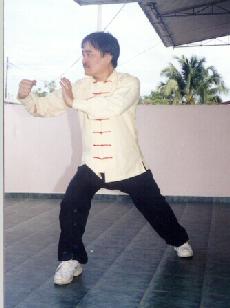
Hence, whenever you perform a kungfu pattern you are actually experiencing in a stylised way the accumulated effort of kungfu masters' fighting techniques; and whenever you perform a kungfu set you are also experiencing the tactical considerations the masters made while linking the patterns into that set.
When you realize this fact, you will better appreciate my contention that those who attempt to modernize kungfu into simplier forms do not understand their art deep enough -- a contention derived from my own master's strong disapproval of those who simplify traditional kungfu into kungfu-do, drawing inspiration from such arts as karate-do and taekwondo.
Why, then, do many kungfu students and instructors not understand these wonderful combat functions of kungfu patterns although they may have performed the patterns hundreds of times. One obvious reason is that kungfu today is normally practised like gymnastics with its martial essence lost. Kungfu students may spar in their training, but what they use in their sparring is usually simple punches and kicks like those in karate and tasekwondo, and not the kungfu patterns they perform in solo practice.
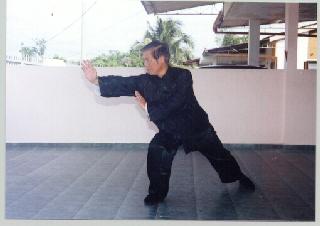
At another level many modern studetns are unaware of, or even disbelieve, these wonderful kungfu application because firstly they are ignorant of such combat application, and secondly even if they know theoretically they lack the skills to execute them.
Let us, for example, look at the three patterns above. The first technique "Hook Hand at False-Leg Stance" is a common pattern in Northern Shaolin, such as Praying Mantis Kungfu. The second picture above shows the pattern called "Hiding a Flower in Sleeves", and is common in Southern Shaolin, such as Hoong Ka Kungfu. Although they are actually very useful in many different combat situations, not many people know how they are used; many people would think they are merely decorative.
The pattern immediately above is called "Double Dragons Across Stream" in Shaolin Kungfu. In Chen Style Taijiquan it is called "Lazy to Roll up Sleeves". The pattern looks simple, and many people would have no difficulty recognizing it as a poise pattern. Indeed it is a very useful poise pattern against an opponent who employs kicks frequently. But this is only one of its many combative functions.
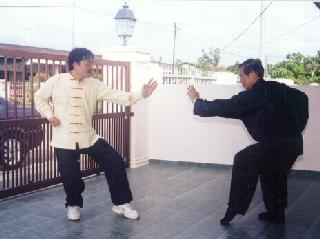
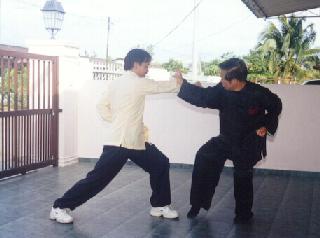
One should use a particular kungfu pattern only when the combat situation warrants it. The following combat sequence illustrates the appropriate use of the various patterns in question.
Goh Kok Hin and I observe each other in our poise patterns. Goh attacks me with "Black Tiger Steals Heart" and I respond with "Single Tiger Emerges from Cave".
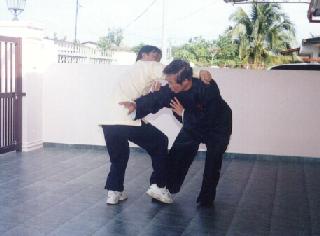
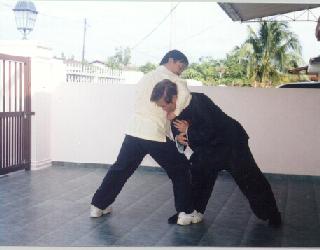
The thrust punch is a feign. As soon as I attempt to defend against his punch, Goh swiftly moves his right leg forward to a False-Leg Stance along my front (free-moving) leg to prevent me from kicking at him, uses his left hand to guard against my right (nearer) hand to prevent me from striking him, and hook his right arm around my neck -- all in one smooth continuous action. This pattern is "Hook Hand at False-Leg Stance".
The next photograph shows the result of this action, and the pattern is "Hiding Flower in Sleeves". Someone merely looking at the end result may think that it is impossible to lock the opponent's head in this way, but an exponent well trained in this technique and has the necessary skills can execute it quite easily. If the exponent is skilful enough, often it does not matter how the opponent responds to the initial feigning attack. As soon as the opponents make a response to the feign, the exponent would move in to lock the opponent's head.
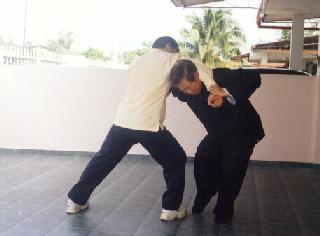
Fortunately I am also well trained to counter such a head lock. Before Goh could complete circulating his arm around my neck, I grip his right wrist and right elbow to frustrate his lock. Immediately I move my right leg in between his legs and adjust myself in the best position to prevent his possible counter-attack with his other hand, and simultaneously tighten my left hand grip on his right wrist and pull down, push up my right hand at his right elbow to dislocate it, and strike his right ribs with my right elbow. The pattern here is "Fierce Tiger Crouchomg at Cliff".
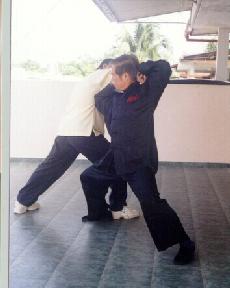
How would you get out from such a difficult situation? If you know how and have the necessary skill, it is quite easy, as follows. Goh Kok Hin uses his left hand to push away my right elbow, and immediately exerts internal force using the pattern "Double Dragons Across Stream", sending me to fall away.
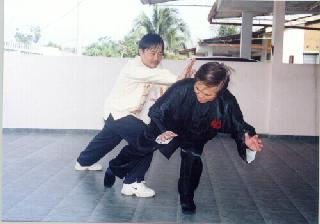
It is quite obvious that to apply this "Double Dragons" pattern well against the "Fierce Tiger Crouching at Cliff", one needs not only the technique but also appropriate skills and sufficient force. If you think that it is impossible to neutralize a complex combat situation with such an apparently simple pattern, try it out yourself a few times, and you will be amazed at the profundity of kungfu.
If you have seen the movie film "Enter the Dragon" starred by the celebrated Bruce Lee and the martial art master Chuck Noris, you would remember that the hero killed his opponent using such a head lock. Had the opponent known this application of "Fierce Tiger Crouching at Cliff" he would have been saved.
But this "Fierce Tiger" pattern has to be applied before the exponent has completed his hold. What would you do to save your life if the head lock has been completed? This will be explained in another webpage.
